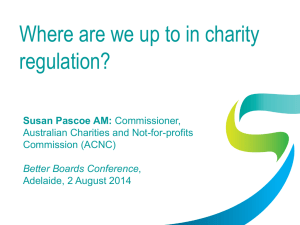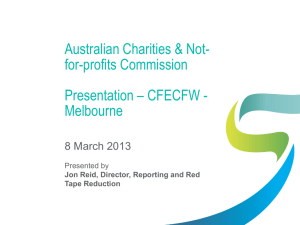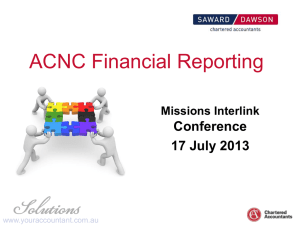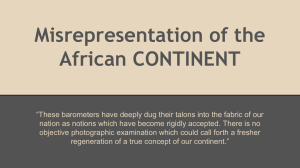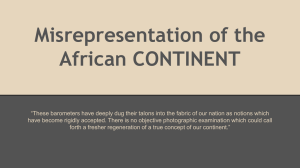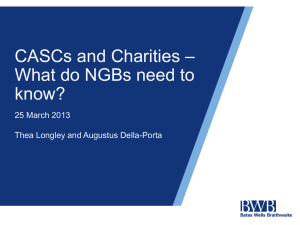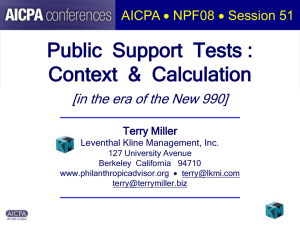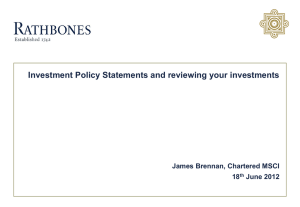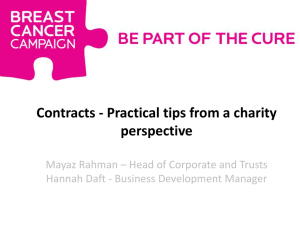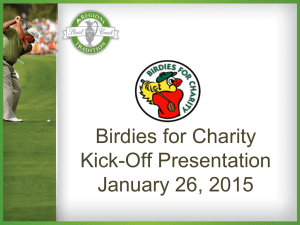ACNC community presentation - The Uniting Church in Australia
advertisement
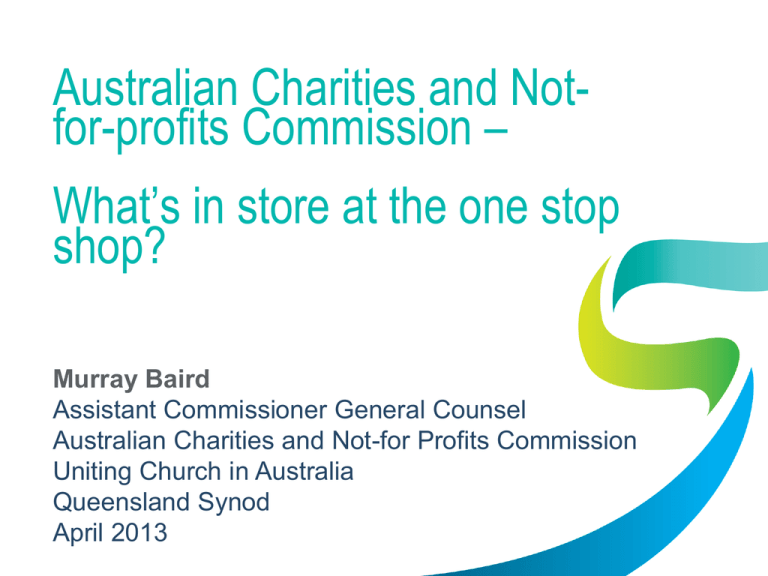
Australian Charities and Notfor-profits Commission – What’s in store at the one stop shop? Murray Baird Assistant Commissioner General Counsel Australian Charities and Not-for Profits Commission Uniting Church in Australia Queensland Synod April 2013 The Churchwardens’ complaint… “[the Trustees] have omitted to distribute, yeld and deliver unto the poore, sicke and nedye paryshyoners of the said poore paryshes… and the poore prysoners in Newgate… eight shillings.. to be bestowed in good newe and sweete bread” Sir Nicholas Bacon Lord Keeper 1558–1579 An Act to reforme Deceits and Breaches of Trust 1597 “[Charitable Funds] have bene…most unlawfully and most uncharitably converted to the lucre and gayne of some few greedy and covetous persons contrary to the true intent and meaning of the givers…” Elizabeth I 1533 –1603 Charitable Uses Act 1601 “Commissions to inquire into any breach of trust, falsity, non employment, concealment, misgovernance or conversion of charitable funds” The Milkmaid Vermeer 1658 An Australian Charities Commission a new independent statutory agency, the Australian Charities and Not-for-profits Commission (ACNC), by 1 July 2012 and related structural changes required to the Australian Taxation Office Federal Budget May 2011 Dedicated and focused regulator “The lack of an independent national regulator with a dedicated focus on the needs of the sector has hindered more streamlined regulation across Australia.” Assistant Treasurer David Bradbury Second Reading speech 23 August 2012 Need for reform - Slow Train Coming • • 2001 Definition of Charities 2008 Disclosure Regimes for Charities and NFP Organisations • 2010 Productivity Commission : Contribution of the Not-for Profit Sector • 2010 • 2010 Henry Review • 2010 Senate Economic Legislation National Compact Committee inquiry Scope of the Sector • 600,000 not-for-profit groups • 60,000 charities (welfare, education, religion and other recognised charities) • 4% of GDP/$43b. • 7.8% growth p.a. • One million employees – 8% of employees • 4.6m volunteers Charity sector: Who is in? • • • • Welfare and disability; (Non Government) Schools, Universities etc; Churches, Religious organisations Conservation, Arts, Childcare, Community infrastructure What will ACNC Do? Registration Compliance Education and guidance Information Trust Maintain, protect and enhance public trust and confidence in the Australian not-for-profit sector. ACNC object 1: Maintain, protect and enhance public trust and confidence in the Australian not-for-profit sector • • • • • • • • 56,000 charities from ATO register of tax concession charities Online charity registration – 100% take-up 240 new charities registered with the ACNC Average registration time: 8.3 days 75 complaints / concerns about charities received by ACNC Advice Services Basic ACNC Register established –50,000 visits Increased public awareness of the ACNC Register 80,000 visitors to website The ACNC Register • free, online, public register of ACNC registered charities at acnc.gov.au. Initial information on the ACNC Register includes the charity’s: • legal name • Australian Business Number (ABN), which links to their record on ABN Lookup. This record includes basic information such as the types of tax concessions your organisation receives and whether it has the deductible gift recipient (DGR) status • state or territory of registration. – continued… The ACNC Register In future, the ACNC Register will also list: • • • • • • • business address and contact details the type of charity it is registered as registration date responsible person details (including names and positions) a copy of the governing rules the annual information statements provided to the ACNC, including financial reports and audit reports if the charity is medium or large and therefore required to provide these enforcement action taken by the ACNC (such as warnings, directions, or removal of director) The ACNC Register Health Support and sustain a robust, vibrant, independent and innovative Australian not-for-profit sector ACNC object 2 Support and sustain a robust, vibrant, independent and innovative Australian not-for-profit sector • 13 ACNC open for 12 hours on weekdays (8 am to 8 pm AEDST) • 2000+ calls answered in 11 seconds (on average) • Enquiries: 457 emails, 159 written queries and 13 faxes responded to in 1 day (on average) • acnc.gov.au 44,877 visits On our website: • Factsheets • Guide to the ACNC Act in plain language • Detailed guides, quick tips, frequently asked questions. How the ACNC can help your charity? Cut Red Tape Reduction of unnecessary regulatory obligations on the Sector ACNC object 3. Promote the reduction of unnecessary regulatory obligations on the sector • ACNC Reporting and Red Tape Reduction Directorate • ACNC Chair Reducing Regulatory NFP Duplication Working Party with the DPC • Data Standardisation – adoption of the National Standard Chart of Accounts (NSCOA) and alignment with Standard Business Reporting (SBR) • Charity Passport – progressively implemented from July 2014 - ACNC collect data from registration and AIS and provide to authorised Cwlth agencies = key element of report-once, use often. Progress in red tape reduction continued • Streamlined Reporting Working Groups across Cwlth (eg DEEWR, ISCA, ACARA, NCEC for non-govt schools) • Commonwealth Grant Guidelines have been amended to improve and simplify interactions around grants between the Government and the sector • Working with other regulators (eg ASIC and ORIC) to remove or minimise duplication • Collaborating with State and Territory government agencies to minimise duplicated regulatory obligations wherever possible (eg SA) • Annual Report to Parliament to map progress in achieving meaningful red-tape reduction for charities. Registered Charities: Obligations to the ACNC The situation at 3 December 2012 56,000 On 2 Dec 2012, 56,000 charities automatically registered with ACNC ACNC ATO Applicant for charity From 3 Dec 2012 orgs apply to ACNC for charity status From 3 Dec 2012 ATO applies tax law only Obligations to the ACNC To maintain ACNC registration, all registered charities need to: • notify us of certain changes, such as: – service address, legal name, governing body members, governing rules • keep records – financial records, operational records • report to us each year • meet governance and external conduct standards from 1 July 2013. • Some exemptions for basic religious charities and non-government schools. Reporting Obligations to the ACNC Obligations vary depending on the charity’s size • Small charities do not need to provide as much information as medium or large charities. A charities size is determined by its annual revenue • small – annual revenue less than $250 000 • medium – annual revenue between $250 000 and $1 million • large – annual revenue is $1 million or more. Reporting to the ACNC Annual information statement (AIS) • • • • All registered charities have to submit an annual information statement The AIS will be brief and cover information that charities already know, such as: – how the charity works towards its charitable purpose – the number of volunteers and paid staff – the type of people (or animals!) who benefit from the charity's activities. Where we already have information we will pre-populate the AIS The first AIS is due six months after the 2012–13 reporting period (for most this will be December 2013) Regulatory approach • Light-touch, risk-based, evidence-based approach • Provide information, guidance and education • Use graduated powers, provide opportunity for selfcorrection • Regulatory Principles: relevance, proportionality, consistency, transparency, timeliness • Currently finalising our regulatory approach, following public consultations Deregistration Graduated Sanctions Investigation Assistance Guidance More work to be done • Governance Standards now in Regulations subject to disallowance. Effective 1 July 2014. • Financial Reporting Requirements – consultation closed 15 February 2013. Regulations not yet published • External Conduct Standards to be released for consultation and regulations Five Governance Standards • Purposes and character of an NFP entity • Accountability to members • Compliance with Australian laws • Suitability of responsible entities • Duties of responsible entities Basic Religious Charities • Registered entity • Advancement of religion • No other sub-type (eg Education, Relief of Poverty); • Not Association or Corporation • No funds >250K revenue; • No government grants >100K • No grouping Benefits of BRCs • No Governance Standards • No financial reports ACNC Mailout Staged mailout to 56,000 charities previously registered with the ATO • • • • First quarter 2013 Form to capture information from you in one interaction The form is also available online as a fillable pdf Information we receive will help us update the ACNC Register • Bulk lodgement process • Please call us if you do not receive the letter Three Hotspots • Unregistered charities for advancement of religion • Funds operated by entities • Part PBI/HPC Who came across to ACNC Register? Schedule 1 ACNC (C&T) Act 2013 • If endorsed as TCC with ATO 2 December 2013, you are automatically registered • 1.1 Endorsed Charities automatically became registered charities • 1.2 Self Assessing Religious Institutions did not come across • Therefore, not registered charities and no longer entitled to tax exemption unless… The Remedy Schedule 1 ACNC (C&T) Act 2013 • If a self assessing entity for advancement of religion notifies ACNC within 12 months that it was a charity 2 December 2012, it will be registered as a charity from 3 December 2012. • Otherwise, need to apply and there may be a gap in exemption. Funds operated by entities Tax Exemption ITAA 1997 The old provision The new provision • S.30-B Table of recipients for deductible gifts • Examples: School Building funds, Scholarship Funds, Necessitous Circumstances Funds, Library Funds etc • 30-17 requirements to deduct a gift you make to a fund; • No requirement to have a separate ABN or be a charity • Fund must be a registered charity • Do you need to apply for ACNC registration for each fund? The Inquiry • Seeking view of ATO as to whether it will require the fund to be a separate entity or if sufficient that a Registered charity operates the fund • Watch this space. Part PBI or HPC The old arrangement • Public benevolent institution could be contained within the structure and governance of another entity • For example, a church denomination could have a welfare department • To demonstrate “institution”, needed to show quarantine of operations and deductible gifts The new arrangement • Treat the parent as if it didn’t have a PBI/HPC and retain its ABN; • Treat the PBI/HPC as a separate entity and within 12 months have a new ABN • ACNC will register PBI/HPC as a separate entity in its appropriate subtype and deem registration from 3 December 2012 Charities Bill 2013 - New definition of Charity • • • • • Not for profit Charitable purposes for the public benefit Ancillary purposes in aid of charitable No disqualifying purposes Not individual, political or government See draft Bill and Draft EM – consultation until 3 May Charitable Purpose • • • • • • • • • • • • Advancing health; Advancing education; Advancing social or public welfare; Advancing religion; Advancing culture; Promoting reconciliation/mutual respect/tolerance; Human rights; safety of general public; Suffering of animals; natural environment; Analogous purposes; Change or opposing change in the law to to aid the above purposes Finding out more: www.acnc.gov.au Providing you with access to information is a priority for us • • • • • • • Weekly Commissioner Column (sent to 6,193 subscribers) Media alerts and releases and newsflashes Aboriginal Liaison officers podcasts and videos – coming soon Phone: 13 ACNC (13 22 62) 8 am to 8 pm AEDST Email: advice@acnc.gov.au Social media: facebook.com/acnc.gov.au twitter.com/acnc_gov_au youtube.com/ACNCvideos Questions
